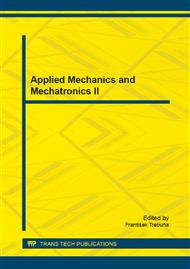[1]
A. Kucaba-Piêtal, Contemporary methods and trends for calculating wind tunnel interference corrections, Institute of Aeronautics and Applied Mechanics: Bulletin Warsaw University of Technology. 6 (1997) 270-273.
Google Scholar
[2]
T. Wright, Fluid Machinery: Performance, Analysis, and Design. CRC Press, Cornelia, Georgia, USA, (1999).
Google Scholar
[3]
W. W. Peng, Fundamentals of Turbomachinery. John Wiley and Sons, Fresno, California, USA, (2007).
Google Scholar
[4]
R. Dvořák, Jednorozměrné proudění stlačitelné tekutiny. Zpráva Z – 1199/94, UT AUČR, (1994).
Google Scholar
[5]
M. Čarnoguská, P. Šafařík, T. Hyhlík, Odvodenie zákona mechanickej podobnosti prúdenia rozmerovou analýzou. Acta Mechanica Slovaca. 3 (2000) 20-24.
Google Scholar
[6]
M. Čarnogurská, M. Příhoda, D. Popčáková, Modelling the flow conditions in the tunnel and its reduced model. Journal of Mechanical Science and Technology. 24 (2010) 2479-2486. DOI 10. 1007/s12206-010-0810-9.
DOI: 10.1007/s12206-010-0810-9
Google Scholar
[7]
M. Kozubková, S. Drábková, P. Šťáva, Matematické modely nestlačitelného a stlačitelného proudění. Metoda konečných objemů. Ostrava, VŠB-TU, (1999).
Google Scholar
[8]
C. Pozrikidis, Fluid dynamics: Theory, Computation and numerical Simulation, Kluwer Academic Publishers, Massachusetts, USA, (2009).
Google Scholar
[9]
A. Shimanovsky, A. Kuzniatsova, A. Sapietová, Modeling of Newtonian and Non-Newtonian Liquid Sloshing in Road Tanks while Braking. Applied Mechanics and Mechatronics. 611 (2014) 137-144. DOI: 10. 4028/www. scientific. net/AMM. 611. 137.
DOI: 10.4028/www.scientific.net/amm.611.137
Google Scholar
[10]
P. Nemec, M. Malcho, M. Smitka, J. Matušov, Performance parameters of closed loop thermosyphon. Communications. 14 (2012) 53-57.
DOI: 10.26552/com.c.2012.4a.53-57
Google Scholar
[11]
J. Kalčík, K. Sýkora, Technická termomechanika, Academia Praha, (1973).
Google Scholar
[12]
T. Brestovič, N. Jasminská, M. Čarnogurská, M. Puškár, M. Kelemen, M. Fiľo, Measuring of thermal characteristics for Peltier thermopile using calorimetric method. Measurement. (53), 2014, 40-48.
DOI: 10.1016/j.measurement.2014.03.021
Google Scholar
[13]
S. Medvecká-Beňová, I. Virgala, M. Kelemen, Ľ. Miková, Influence of material and gear parameters on the safety of gearing in metallurgical industry, Metalurgia. 54 (2015) 224- 226.
Google Scholar
[14]
M. Raudensky, M. Pohanka, J. Horsky, Heat transfer coefficient estimation by inverse conduction algorithm. International Journal of Numerical Methods for Heat & Fluid Flow. 3 (1993) 257-266.
DOI: 10.1108/eb017530
Google Scholar


